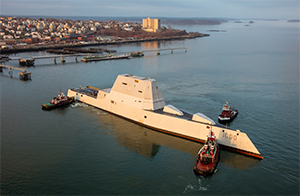On a cold, gray afternoon, the tugboat Andrew McAllister arrived at the entrance to Maine’s Portland Harbor and spun 180 degrees. From its stern, the U.S. Navy’s “stealth ship” was barely visible on the horizon.
The destroyer USS Zumwalt (DDG-1000) was returning to Portland for a quick stop after three days of sea trials in the North Atlantic Ocean. Andrew McAllister and the tugs Rowan M. McAllister and Patricia Winslow were waiting at Portland Head to escort the 610-foot ship into port.
Inside Andrew, Capt. Brian Fournier was preparing to climb aboard Zumwalt, which has an unusual design reminiscent of the B-2 stealth bomber. From its wheelhouse, serving as docking pilot, Fournier would guide the ship stern-first into berth at downtown Portland.
Fournier, the president of Portland Tugboats, was the first pilot to climb aboard the $4.4 billion destroyer in December when it arrived in Portland after an initial round of trials. He was a little nervous before that job, but this time felt completely at ease.
“It’s a little more routine now,” he said over coffee in the tug’s galley. “That first time she came in here, we weren’t certain where we were going to put her, where she was going to line up at the pier, and I wasn’t certain how she was going to handle because it was her first voyage.”
Still, Fournier relished the chance to control the Navy’s newest ship, even for just a half-hour.
“It’s just such a massive amount of power,” he said. “That has more power than any ship I’ve been on, and probably some of them combined.”
Zumwalt is a guided-missile destroyer built at Bath Iron Works (BIW) in Bath, Maine. The ship uses a “wave-piercing” tumblehome hull and composite superstructure intended to make the ship harder to detect at sea. It can accommodate two MH-60R helicopters or three drone aircraft in its hangar and can sail at 30 knots.
Although the Zumwalt program once called for more than two dozen ships, it now calls for just three. The second ship in the class, DDG-1001, is named for Navy Seal Michael Monsoor, who was posthumously awarded the Medal of Honor for heroism in Ramadi, Iraq. The third vessel is named for former President Lyndon B. Johnson.
Zumwalt was nearly finished with four days of builder trials in the North Atlantic when it made its two-hour stopover in Portland on March 23. The ship left Portland that same night for crew familiarization exercises before returning to Bath Iron Works on March 24.
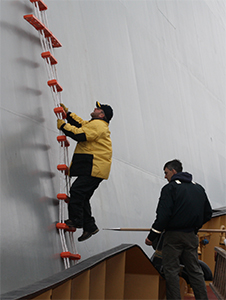 |
|
Docking pilot Brian Fournier climbs aboard the ship while Andrew McAllister engineer Ed Holland uses a hook to snag the line. |
|
Casey Conley |
“BIW tested numerous systems on the ship, including propulsion, steering, life safety and more,” said Matt Wickenheiser, a spokesman for Bath Iron Works. “We were pleased with the ship’s performance, and are working hard with the Navy and other naval contractors toward acceptance trials and, ultimately, delivery.”
Capt. Thurraya Kent, a Navy spokeswoman, said the trials offered the crew a rare chance to train side-by-side with industry representatives.
“The Navy will continue to assess system performance over the coming weeks in preparation for acceptance trials next month,” Kent said in a statement in March. The ship is scheduled for delivery later this year. Commissioning is expected in October.
Andrew McAllister left its berth at the Maine State Pier in downtown Portland at about 1600 on March 23, and Rowan M. McAllister departed minutes later. Soon, the vessels arrived at Portland Head in Cape Elizabeth, which marks the entrance to Portland Harbor. Patricia Winslow of Winslow Marine also stood by.
Fournier earned his captain’s license in 1993 and considers tugboats his first love. His father, Arthur Fournier, operated a tugboat company in Boston for many years before opening Portland Tugboats in 1985. Fournier’s two brothers, Douglas and Patrick Fournier, also work in New England ports.
“My true love is tugs,” Fournier said. “We had the tractor tug before, the Vicky (McAllister), and I was a captain on her before I became a pilot. But don’t get me wrong, my job is awesome. Driving ships is awesome.”
Fournier has played a key role moving other large Navy vessels. He joined Capt. Jeff McAllister on the pilot team that moved the USS Intrepid aircraft carrier to its current home at the Intrepid Sea, Air and Space Museum in New York. He helped move USS Forestall and USS Saratoga on their final voyages out of Naval Station Newport.
Although there have been some questions about Zumwalt’s unusual hull design, Fournier said the ship responded beautifully when he piloted it in December.
“It handles remarkably well. She steers like a loaded tanker,” Fournier said. “It takes some rudder to get her going, but she stops and backs remarkably fast.”
The biggest challenges of piloting Zumwalt, he said, were the small wheelhouse windows and the lack of visibility.
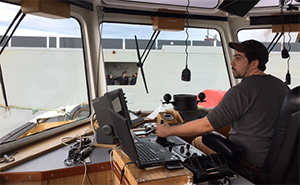 |
|
Capt. John Reeves at the controls of Andrew McAllister on Casco Bay. As the most powerful tug in the flotilla, Andrew was assigned to Zumwalt’s starboard quarter for most of the docking job. |
|
Casey Conley |
“A lot of it is done by camera, but other than that it is still just the bridge of a ship,” Fournier said, noting that the electronics were about the same as large commercial ships.
Any sensitive military equipment, he added, is shut down well before the vessel takes on a pilot.
Zumwalt reached Portland Head at about 1630, passing the iconic Portland Head Light. Winds were light and seas were about 4 feet as the ship overtook Andrew on the tug’s port side.
Capt. John Reeves kept the 6,000-hp Andrew parallel to the ship at about 10 knots while Fournier prepared to board. When it came time for the pilot handoff, Reeves steered the twin z-drives toward Zumwalt. As the two vessels converged, tug engineer Ed Holland grabbed the ladder and Fournier made his way into an open hatch midway up the hull.
With help from a civilian crewman, Fournier climbed on board and made his way to the wheelhouse. For several minutes, the three tugs chugged forward at about 4 knots, waiting for orders to connect their lines with the hulking ship. Zumwalt was early, and inbound transit was delayed briefly while waiting for longshoremen to arrive at the terminal.
The 4,300-hp twin-screw Rowan remained toward the ship’s bow, while Patricia Winslow stayed off the port quarter. Andrew hung back off the stern as the vessels passed Cushing Island on the starboard side. The fire boat City of Portland IV and a local water taxi watched as the ship passed.
“I won’t call you in just yet, but you know where to go with your line,” Fournier said to Reeves over radio.
Moments later, Fournier requested the three tug captains confirm his orders over the radio. He couldn’t hear their whistles from the ship’s wheelhouse.
After Rowan had tethered up with Zumwalt at the starboard bow and Patricia made fast on the port quarter, Fournier asked Andrew to do the same on the starboard quarter.
“OK Andrew, you can ease over and get your line up,” Fournier said.
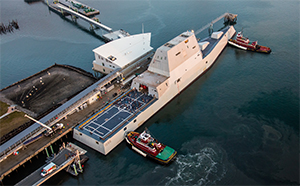 |
|
The Navy destroyer, with the help of the tugboats, slips into the berth at Portland. |
|
Maineimaging.com/Dave Cleaveland |
Reeves steered the tug back toward the ship’s starboard quarter while deck hand Alex Stevens and Holland climbed down to the main deck for the line transfer. Andrew uses a JonRie Series 250 winch on its bow and 9-inch Samson line.
Holland tossed the messenger to a crewman aboard Zumwalt and then tied off the line. Andrew is the most powerful tug in McAllister’s fleet, and the workhorse of Portland Tugboats. It has tremendous backing power, and it was assigned to the starboard quarter for good reason.
“We’re the starboard quarter boat, so we’re going to be pulling the stern around because we’re backing her into the slip,” Reeves explained.
Portland Harbor was once the busiest petroleum port on the East Coast. Commercial traffic has fallen off sharply in recent years. The mild winter reduced demand for heating fuels, and paper mill closures in central and northern Maine mean less need for inbound coal and outbound paper products. The future of the Portland Pipe Line linking South Portland with Montreal is in question amid local opposition to the loading of shale oil onto tankers.
On a given day, Portland Tugboats usually has at least one escort job, Fournier said. But the port is slowing down, and there are days with no ships coming or going.
With its sleek hull and sharp angles, Zumwalt is one of the most visually striking ships in the world and an unusual job for any tug. Reeves admitted as much but said it was effectively no different than the company’s regular escort work.
“It’s unique in that it’s a very unique ship, but as far as working this particular job … we would do this with any other job,” he said, adding, “maybe not with three tugs though.”
Passing Spring Point Ledge Lighthouse and then Bug Light off the port side, the vessels made their way into the Fore River with downtown Portland in the background. As the vessels were parallel with the mainland, Fournier called out a series of orders to begin turning and backing the ship into Ocean Gateway.
“Andrew, backing easy on 90,” Fournier called.
“Backing easy on 90,” Reeves confirmed.
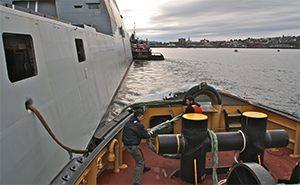 |
|
Aboard Andrew McAllister, Holland and deck hand Alex Stevens tie off alongside Zumwalt. |
|
Casey Conley |
“Andrew, back half,” Fournier said moments later, which Reeves again confirmed over radio.
Ocean Gateway is a city-owned facility with a landing ramp extending from the mainland into the water to serve vehicles coming and going from an overnight ferry to Nova Scotia. It has a deepwater berth that runs parallel to shore to accommodate cruise ships.
As Zumwalt slowly backed toward the ramp, Fournier sought regular updates about the distance separating the ship from shore. Multiple crewmen standing at the ship’s stern relayed the distances to the wheelhouse over radio.
“Dave, stop and hold,” Fournier called to Capt. Dave Mason, who was helming Rowan.
“Stop and hold,” Mason responded.
At about 1530, as Fournier oversaw the landing, a Kirby articulated tug-barge (ATB) departing the Sprague Energy terminal requested approval to pass the Navy ship.
“I just wondered if it’s OK to pass forward of your bow on the South Portland side (of the Fore River),” the Kirby captain asked.
The ATB received the OK and crept past Zumwalt with plenty of room to spare.
With 150 feet separating the stern and the landing ramp, Fournier directed Patricia to haul in its line. Then, he began a series of commands to Andrew and Rowan to guide the ship toward the landing. Fournier continued to get distance updates from the stern crewmen.
At 100 feet, Fournier ordered Andrew to all-stop, and then to push very easy. Reeves used the tug’s JonRie bow winch to haul in about 20 feet of line. The shorter line, he said, makes the tug more responsive to Fournier’s commands.
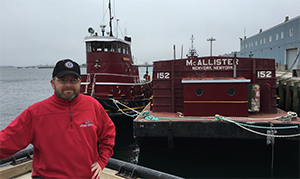 |
|
Aside from being a docking pilot, Fournier has been a licensed tug captain since 1993 and is president of Portland Tugboats, a unit of McAllister Towing. |
|
Casey Conley |
With around 50 feet to go, the ATB Ruth Reinauer made arrangements with Fournier to pass in front of the ship. This ATB was inbound for the Sprague Energy terminal on the Fore River.
As Zumwalt inched back toward the landing, crewmembers positioned on the ship offered competing assessments about the distance. One thought the ship had about 40 feet to go, while another thought it was about 70 feet.
“We’re going to take your word for it, Tommy,” Fournier responded.
“Yeah, I might be a little conservative, Brian, but keep her coming,” said the other crewman who estimated the shorter distance.
“That’s OK, conservative is OK,” Fournier answered.
With 20 feet to go, Fournier called for both tugs to stop and hold as the ship inched back. Over the next minute or so, he alternated requests for each tug to push easy and stop while the ship’s momentum carried it toward the landing.
“Another eight, Brian, we’re coming nice,” said one of the stern men.
“Another eight,” Fournier confirmed.
The ship crew worked to set the lines while the tugs alternated between pushing and stopping. With just a few feet to go, the vessel continued toward the landing.
“She just doesn’t want to stop,” Reeves observed. “She must be getting pretty close.”
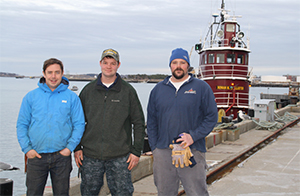 |
|
The crew of Rowan M. McAllister, deck hands Ian Lukas and Pete Rodriguez, serving with Capt. Dave Mason. |
|
Casey Conley |
Moments later, Fournier got word that the lines were in place. He secured the engines and waited for a crane to lower a gangway between the ship and the pier.
Fournier released Andrew first and ordered it to stay close to Zumwalt’s hull where the water was deepest. Reeves steered past Rowan and traveled about 300 yards back to the Portland Tugboats berth at the Maine State Pier. Rowan soon followed.
With Andrew tied up, Reeves said the escort job went as he well expected. The only difference was using the radio to confirm the pilot’s commands instead of the whistle.
Fournier disembarked along with dozens of Bath Iron Works employees and civilian contractors. He walked the quarter-mile or so overland to the tugboat office.
He likened his job to that of an orchestra conductor. And in this case, the instruments played in unison. The smooth landing did not go unnoticed by Zumwalt Capt. James Kirk.
“Capt. Kirk complimented me. He said I drove his ship smartly,” Fournier said.
After a well-deserved break and sushi dinner, Andrew’s crew was due back at 1930 to escort Zumwalt back out of the harbor. Other jobs were scheduled later that night, including shifting the Irving Oil tanker Acadian.
It was a busy night in the harbor, and the tugboat crews were there to keep the vessels moving.

